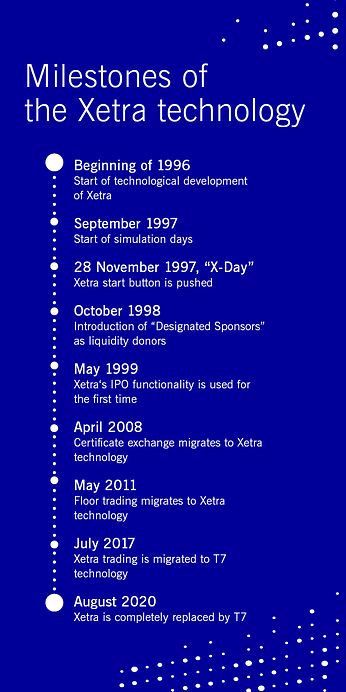Xetra - the electronic trading platform of Deutsche Börse
Xetra - the electronic trading platform of Deutsche Börse
Shares have been traded in Frankfurt for 200 years but have only been traded fully electronically for just over 20 years. The launch of Xetra marked the beginning of a success story in modern securities trading. With a market share of around 90 percent, Xetra is today not only the home exchange for German blue chips, but also the leading exchange for ETFs in Europe.
On 28 November 1997 Deutsche Börse pressed the start button of Xetra. This marked the beginning of a success story in modern securities trading. The technology of a fully electronic trading system was introduced for the Frankfurt Stock Exchange with the aim of enabling growth in trading volume and the number of securities traded as well as opening up new markets and segments.
The name Xetra was used in two respects: firstly, for the fully electronic trading platform "Xetra" on the Frankfurt Stock Exchange and, secondly, for the technology that had long been behind the system. The abbreviation "Xetra" originally stood for "eXchange Electronic TRAding".
How it all began
The foundation stone for the development of Xetra was laid at the beginning of the nineties with the launch of the European single market. This also brought into force a European passport for securities - a blanket authorisation for banks and securities companies to trade, set up branches and offer their securities in the EU area. Banks could now become participants in a European stock exchange without having to have a local presence on the exchange. This was a major step, since on the one hand, trading on the Frankfurt Stock Exchange had previously been subject to a compulsory presence and, on the other, IBIS, the integrated stock exchange trading and information system used at the time, did not have the technical facilities to handle the expected surge in trading volume.
It was also important to take into account the banks' desire for greater transparency. Until now, stockbrokers on the Frankfurt trading floor have been guardians of transparency, which was not enough for many market participants. The introduction of the open order book on Xetra has decisively improved trading transparency and is still one of its key success factors today.
Protection in extreme situations
In anticipation of extreme market conditions, Deutsche Börse also introduced protective mechanisms with the launch of the electronic trading platform to ensure the integrity of trading in such market situations, independent of human intervention. The most important of these is the volatility interruption. It ensures that exchange trading functions smoothly even in extreme market situations - regardless of whether there are price jumps in the market as a whole or in individual stocks. The aim is to decelerate trading, give market participants time to orient themselves and prevent the market from moving unchecked in one direction.
Intelligent enhancements developed
Over the years, the technology of the fully electronic trading centre has been optimised again and again to be able to process more and more trading orders faster. A precise knowledge of the liquidity in the market also helps to ensure optimal order execution. With the Xetra liquidity measure, a key figure for Xetra trading was introduced in 2002, which calculates the implicit transaction costs and thus measures liquidity in a key figure. The lower the XLM, the lower the market impact costs incurred in trading - and the higher the liquidity of an instrument. This has a positive effect on trading efficiency. In 2019, the XLM was expanded to include the Intraday XLM (iXLM for short) for ETFs. The iXLM provides information on how the trading costs of an ETF have developed over the course of the day. For calculation purposes, the trading day from 9:00 to 17:30 is divided into half-hourly intervals and the iXLM is calculated retroactively for every half hour. These values are published once a month in the ETF statistics.
Migration to T7 technology
After Xetra's trading infrastructure had proven its speed, reliability and stability over almost two decades with a total of 16 release versions, it was time for a more radical upgrade in 2017. The goal: to master the technical challenges that are expected in the future. In July 2017, the IT system on which Xetra trading is based will be replaced by modern T7 technology. Since then, trading participants benefit from further reductions in latency and synergies, as T7 is also used on the Eurex derivatives exchange.
In August 2020, the floor trading of the Frankfurt Stock Exchange was converted to T7 in the final step. This successfully completed the migration. Around 1.4 million securities can be traded on the new trading architecture.
Xetra today
The Xetra trading platform currently accounts for around 90 percent of the total trading volume of all German stock exchanges; at European level, 75 percent of the volume of all German blue chips is traded here. With more than 2,700 liquid tradable securities, including German and international shares as well as exchange traded products such as ETFs, the daily turnover is around 4.6 billion euros.
